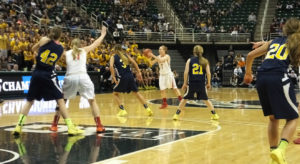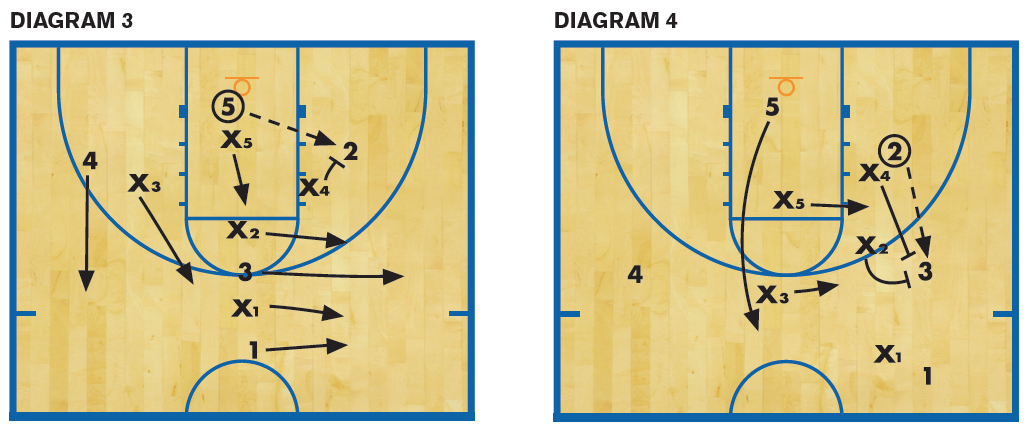‘Jam press’ puts sustained pressure on the ball
The key to a successful press defense is sustained pressure on the ball — keeping the “point of the spear” against the jugular of your opponent. But that pressure typically is only applied after a made basket or turnover. The “jam press” is designed to put sustained pressure on the ball on every possession.
‘Jam press’
 This press is initiated on the rebound, and the key is getting a “jam” on the player who rebounded the ball. Typically, on a rebound by the opponent, players are programmed to retreat on defense. With the jam press, the mindset is to attack the rebounder with at least one player who is the closest to the rebounder.
This press is initiated on the rebound, and the key is getting a “jam” on the player who rebounded the ball. Typically, on a rebound by the opponent, players are programmed to retreat on defense. With the jam press, the mindset is to attack the rebounder with at least one player who is the closest to the rebounder.
There will be times when the rebounder successfully outlets the ball. When that happens, regular rules for pressing apply. However, if the rebounder is held up by a jam or trap, then the press aspect of the defense kicks in. This press defense requires trapping rotations that may be unfamiliar to your players. They usually have designated spots in a regular press according to the position they play. But the “point of the spear” on the jam/jam-trap transition press could be any of your players. When a shot goes up, the jam responsibility goes to the player closest to the rebounder.
In a regular press, teams also tend to put their 5-player back as the “goalie.” But in a jam transition press, the goalie could be any of the guards. If an all-out jam press is required because of time and score, the goalie can be pulled and used as an interceptor/trapper.
Press implementation
Properly implementing this philosophy varies from team to team. When I coached high school boys, we would spend time during every practice working on jamming, jam trapping and rotations. At lower levels, it’s very difficult to do that because of limited practice time and experience among players.
At the high school level, coaches can really expand the press part of this concept with trapping rotations and playing pressure basketball. The key understanding must be that there’s no substitute for hustling. If your team does not hustle, this approach is not for you. All the trapping and proper rotation techniques won’t matter if you don’t hustle in and out of them. The goal is to make opponents uncomfortable and disrupt their attack.
Here’s what you need to do to implement the jam/jam-trap transition press. If all your team can do is get one jammer to the rebounder, two of the three interceptors can cut off the sideline passing lanes. If the rebounder turns forward, cheat back to cover the middle. The focus should be to take away the ball-side sideline and the middle.
If the rebounder starts to dribble up the floor, the middle defender must stop the ball and force a sideways or backward pass. If a pass is made up the floor, everyone must hustle back on defense. When the pass is sideways or backward, the closest defender must get to the ball and apply pressure to push the player toward a sideline for a trap. When I coached high school boys, the jam-press trapping rotations were particularly effective with the 10-second rule in place.
If a jam-trap occurs on the rebounder, and the rebounder hasn’t turned or made an outlet pass, one interceptor cheats the ball-side sideline while the other tries to anticipate a pass from a middle. If the rebounder turns, the ball advancement must be stopped and a pass forced sideways or backward.
The hard part about this is that the jammer, trapper, interceptors and goalie can be different players each time this is initiated. That means the trapping rotation system must be understood and communicated between players. Usually, in a press after a made-basket, a player’s only initial job may be to run to a specific spot on the floor. The trapping rotation system scrambles all positions into a match-up style zone of jammers, trappers, interceptors and goalie. A player’s role and position on the floor can change from one dribble to the next.
Here’s an example of progressions in the jam press:
DIAGRAM 1: 5 grabs the rebound, and X4 and X5 make a jam trap. Other players set up as shown, with X1 back as the “goalie.” If 5 passes to 4, X3 applies pressure, X5 and X2 take the middle and X1 stays back, giving an initial 2-2-1 look in the trap and a 1-2-1-1 look off the pass and defensive rotation.
DIAGRAM 2: 4 passes back to 5, and the defense rotates accordingly. X5 applies ball pressure as the “jammer,” giving a jammer plus 2-1-1 look.
DIAGRAM 3: 5 passes to 2, and X4 applies ball pressure. Other players rotate as shown, giving a 1-2-1-1 look.
DIAGRAM 4: 2 passes to 3, and X2 joins X4 to make a trap. Other players rotate accordingly, and the goalie is “pulled.” This is more like a 2-3 matchup with all-out trapping.
Potential challenges
The caveat in this approach is that some rebounders are exceptionally quick at outletting the ball up the floor. This thwarts any attempt at a jam or jam press. Your team could become good enough at the trapping rotations that you could still deploy the transition press part of this defense — perhaps a trap at half-court before retreating. But it becomes more vulnerable to a fast break without the jam.
Just switching your mindset from retreating to attacking the rebounder allows your trappers to be quicker to the jam. It also makes your interceptors more aware of passing angles and their place on the court in conjunction with ball pressure and trapping angles.
The jam/jam-trap transition press can be a useful defense to any coach on most transition possessions. There should be no need to wait until after a made basket to apply pressure. You can implement pressure at the get-go, increasing your chances of forcing a turnover. That’s especially helpful to undersized, quick teams — this press could be your ticket to competing against bigger players. You can catch them at their most vulnerable, forcing them to dribble or pass out of pressure against faster players.
If you count on defensive rebounds against a bigger team, it usually doesn’t work out. No coach likes to see three, four or five consecutive offensive rebounds against their players — it’s extremely disheartening. With the jam/jam-trap transition press, you develop an aggressive, competitive mindset. That can make all the difference.
Joseph Kubacki has coached high school and grade school basketball in Massachusetts since 1976.












